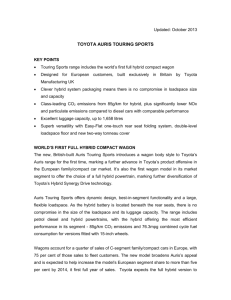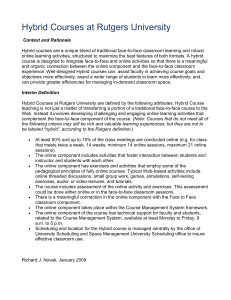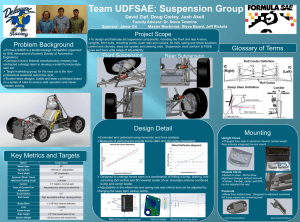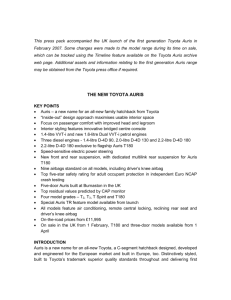Updated: August 2014 TOYOTA AURIS TOURING SPORTS KEY
advertisement
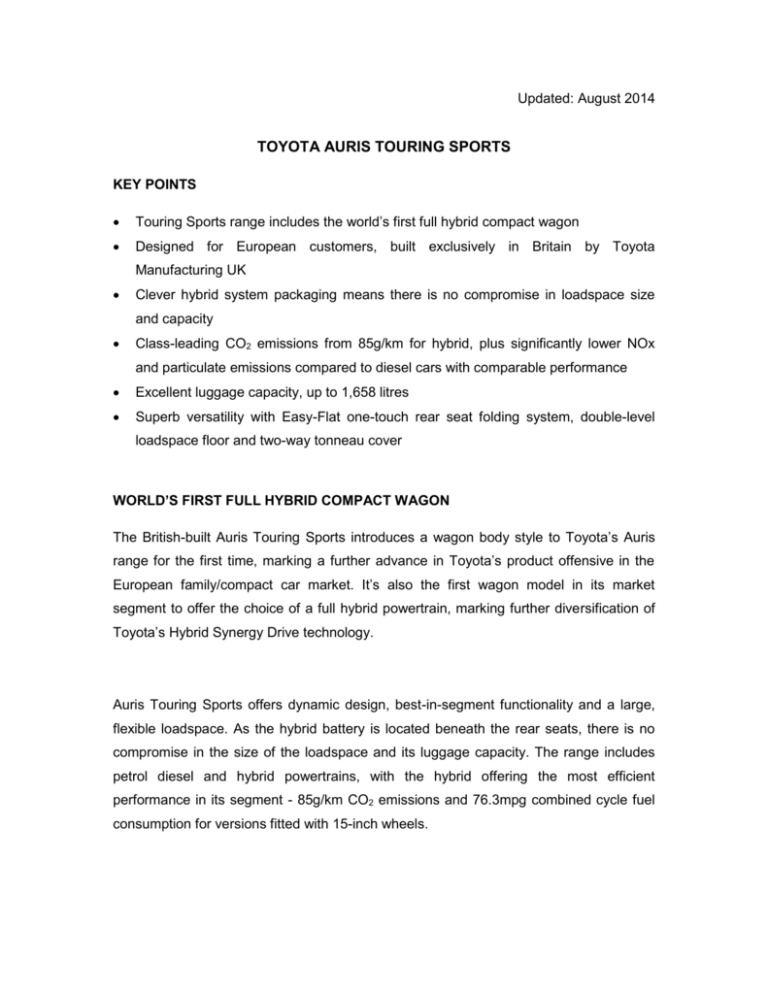
Updated: August 2014 TOYOTA AURIS TOURING SPORTS KEY POINTS Touring Sports range includes the world’s first full hybrid compact wagon Designed for European customers, built exclusively in Britain by Toyota Manufacturing UK Clever hybrid system packaging means there is no compromise in loadspace size and capacity Class-leading CO2 emissions from 85g/km for hybrid, plus significantly lower NOx and particulate emissions compared to diesel cars with comparable performance Excellent luggage capacity, up to 1,658 litres Superb versatility with Easy-Flat one-touch rear seat folding system, double-level loadspace floor and two-way tonneau cover WORLD’S FIRST FULL HYBRID COMPACT WAGON The British-built Auris Touring Sports introduces a wagon body style to Toyota’s Auris range for the first time, marking a further advance in Toyota’s product offensive in the European family/compact car market. It’s also the first wagon model in its market segment to offer the choice of a full hybrid powertrain, marking further diversification of Toyota’s Hybrid Synergy Drive technology. Auris Touring Sports offers dynamic design, best-in-segment functionality and a large, flexible loadspace. As the hybrid battery is located beneath the rear seats, there is no compromise in the size of the loadspace and its luggage capacity. The range includes petrol diesel and hybrid powertrains, with the hybrid offering the most efficient performance in its segment - 85g/km CO2 emissions and 76.3mpg combined cycle fuel consumption for versions fitted with 15-inch wheels. Wagons account for a quarter of sales of C-segment family/compact cars in Europe, with 75 per cent of those sales to fleet customers. The model broadens Auris’s appeal and is expected to help increase the model’s European segment share to more than five per cent by 2014, it first full year of sales. Toyota expects the full hybrid version to achieve around a 45 per cent share of Auris Touring Sports sales, demonstrating how hybrid technology has successfully moved from being a niche choice to mainstream option. Auris Touring Sports has been designed for Europe, its largest volume market. It is built exclusively by Toyota Manufacturing UK (TMUK) at its factory in Burnaston, Derbyshire, alongside the Auris hatchback and Avensis models, reinforcing Toyota’s commitment to its European operations. UK sales began on 1 July 2013. SUPERIOR LOADSPACE AND BEST-IN-SEGMENT FUNCTIONALITY Luggage capacity up to 1,658 litres Loadspace length extends beyond two metres Toyota Easy Flat one-touch folding rear seats, plus dual-level load floor (Icon grade and above) Auris Touring Sports has the same 2,600mm wheelbase and 10.4m turning circle as its sister hatchback, but is 285mm longer overall – all dedicated to the extended loadspace. With the rear seats in place the load area is 1,115mm long and 1,452mm wide, giving a capacity of 530 litres. With the 60:40 split-folding rear seats folded flat the length increases to 2,047mm; with loadspace height up to 890mm (760mm with the double floor deckboard in place), the maximum capacity is 1,658 litres, among the best in the car’s class. Thanks to the fact the hybrid battery has been located beneath the rear seats, luggage capacity in the hybrid matches that of the petrol and diesel models in the range. As well as being more capacious than its rivals, Auris Touring Sports offers better functionality, too. Ease of use and flexibility are assured by Toyota’s Easy-Flat one-touch folding rear seat system and a dual-level loadspace floor. There’s also a two-way tonneau cover, a roller-type luggage net, shopping bag hooks, roof rails (black finish for Active and Sport, aluminium for Icon and Excel), three 12V power outlets (one of which is in the boot) and a loadspace light. The practicality extends to a generous range of storage points, including a glove box, sunglasses holder, coat hooks, coin box, four cup and four bottle holders, a sliding centre armrest with document holder and stowage space for small items in the dashboard and rear centre console. There’s additional storage space in the luggage area, with wall boxes each side of the compartment and secondary side boxes beneath the deckboard. The bumper and tailgate design drops the sill height by 100mm compared to the Auris hatchback, to 624mm above the ground. An optional Towing Pack is available for the Auris Hybrid Touring Sports, enabling loads up to 345kg to be towed. EXTERIOR DESIGN Stylish road presence Aerodynamic styling delivers 0.28 coefficient of drag (Cd) Optional Skyview, the largest panoramic roof in its class As witnessed in the Auris hatchback, the strong and distinctive exterior design maximises the aerodynamic benefits that come with the model’s lower overall height and the dynamic improvements offered by its lower centre of gravity. Thanks to precise handling of the aerodynamics, the car’s coefficient of drag is just Cd 0.28, contributing to improved handling stability and reduced fuel consumption. It shares the same front-end treatment as the hatch, displaying key elements from Toyota’s new design language with focus on emphasising the car’s width and low stance in the shape and arrangement of the wide, trapezoidal lower grille, front bumper and fog lights, together with a keen-edged look created by the narrower upper grille, headlamp units and LED daytime running lights. The upper grille is set beneath a low sweeping bonnet line and a larger Toyota badge which is set lower than before. The grille design features a central, chrome-plated horizontal trim bar which appears to extend into the headlamp clusters, accentuating the width of the vehicle. Here the bar flows into an “eyebrow” over the narrow and distinctively styled headlamps, emphasising the very narrow margin between the bonnet and the lights. The headlamp design also incorporates LED daytime running lights, arranged to create a recognisable visual signature. The large lower grille has a gloss black finish and there is a floating chrome accent on the lip spoiler, which again accentuates the car’s width and its planted, solid stance. The integral fog lamp housings either side of the lower grille also have chrome surround detailing. In profile it also shares the hatchback’s steeply raked windscreen, which flows into an extended roofline with aluminium roof rails and an integral rear spoiler. Excel versions of Auris Touring Sports are available with a Skyview panoramic roof; measuring 1,553 by 960mm, it is one of the largest in its class and increases the sense of light and space in the cabin. The extended three-panel side glazing is emphasised by blacked out pillars, with a piano-black finish to the central pillar. The effect is underscored by a chrome trim above the powerful crease along the car’s rising beltline. At the rear bumper and tailgate have a different design to the hatch. The loadspace sill is set 100mm lower and there is a ‘floating’ chrome-finished spoiler. As on the hatchback models, the design of the rear lamp units reinforces the shape of the rear wing, as well as the shape of D-pillar and rear screen. Auris Hybrid Touring Sports displays a number of individual details that set it apart as the flagship of the range. These include a gloss graphite colour for the lower grille and rear diffuser and a hybrid blue shade for the Toyota emblem on the bonnet and tailgate. Hybrid logos are featured on the front wings and a hybrid mark on the tailgate. The hybrid is also offered with different 15 and 17-inch alloy wheel designs. INTERIOR DESIGN Spacious cabin and large loadspace Focus on comfort and ergonomics to benefit the driver Extensive use of soft touch materials Space and comfort for everyone on board were priorities in the design of the interior, which features strong forms, high quality materials and a high sensory quality. The dashboard majors on horizontal lines to reinforce the sense of width and space inside the vehicle, while the instrumentation and switchgear benefit from a driver-focused, ergonomic approach. The driver-oriented nature of the design is further expressed in the strong curve of the hood over the instrument binnacle, which flows down the side of the centre console to help create a driver’s cockpit. The front seats have long fore and aft travel and a generous height adjustment range. Seat height has been reduced by 40mm and the steering wheel tilt angle lowered by two degrees, creating a more engaging driving position. Sports front seats with extra lateral support have also been introduced, standard on Sport grade. The front seat design also makes life more comfortable for rear seat passengers, who gain an extra 20mm in knee room. The instrument binnacle has a clear and simple two or three-dial arrangement with white needles and numerals. A single font is used for the graphics on all the switchgear, which is backlit in clear blue along with the instrument binnacle and the centre console. The co-ordinated look is reflected in a matching satin silver finish used for the meter surrounds, centre stack, transmission tunnel trim, air conditioning and audio controls and the interior door handles. The air vents, audio panel, transmission tunnel, steering wheel and gear lever all have a silver coloured trim, while on higher grade models the dashboard itself is leather trimmed with baseball stitching. The tactile quality of every area which occupants come into contact with has been carefully considered. Soft touch materials are used on the instrument panel’s upper surface and the door trim shoulder areas, and the A-pillars are fabric trimmed. The steering wheel is wrapped in Nappa leather with single baseball stitching. The assist grips and door grips have a soft texture grain and the door armrests are padded. Active grade seats are finished in Komaki fabric with blue trim; Yatomi black trim features on Icon models; and the Yamato fabric for the Auris Sport’s seats has a red trim. Excel grade seats are finished in black velour with leather bolsters. Black leather upholstery is available as an option on Excel petrol and diesel models, with an Ice Grey leather option exclusive to the Hybrid Excel. Auris Touring Sports is available with a black interior colour scheme, featuring matt textures. A leather-like look has been created by combining a geometrical dot pattern with a grain effect. The hybrid models feature a dedicated meter and Eco Drive Support monitor in the instrument binnacle. The shift-by-wire gear lever is finished in hybrid blue and there is also different detailing around the instrument panel. DRIVING DYNAMICS AND SAFETY Low centre of gravity gives better handling and ride comfort Steering revised for more engaging driver feedback Five-star rating in Euro NCAP 2013 crash test programme Auris Touring Sports reinforces Toyota’s commitment to improving the dynamic abilities of its vehicles to give customers a more engaging driving experience. To this end, it carries forward all the improvements made in the second generation Auris hatchback. These include a more rigid bodyshell, a lower centre of gravity, improved suspension and steering, a better driving position and improved NVH performance. Bracing and reinforcements to the underbody and front and rear structures have increased body rigidity, while using high tensile steel in the bodyshell construction has helped keep the vehicle’s overall weight down. Specific to Auris Touring Sports, the frame around the tailgate aperture has been designed with reinforcements that deliver rigidity on a par with the hatchback, even though the body is longer and tailgate opening wider. Thanks to the 55mm overall height reduction, 10mm lower ground clearance and 40mm reduction in front seat height – measures introduced in the latest Auris hatchback – the car’s centre of gravity is lowered, to the benefit it its high-speed stability and cornering agility. The lower centre of gravity also allows for spring rates to be reduced, adding to the ride comfort. Numerous components in the front MacPherson strut suspension have been tuned for Auris Touring Sports, including the upper support, bound stopper, coil spring and shock absorber. Shock absorbers have been fine-tuned to combine enhanced ride comfort with better handling. Auris Touring Sports features either a double wishbone or torsion beam rear suspension system. The double wishbone arrangement is used in the 1.6 Valvematic and Hybrid models, and the torsion beam in the 1.33-litre Dual VVT-i and 1.4 D-4D versions. The electric power steering has been tuned for better feel and driving precision. A more rigid attachment for the steering column ensures a linear steering feel, and a steering control system suppresses changes in steering force, again improving linearity. A higher gear ratio delivers greater steering response. Working together, these improvements deliver more direct operation, better feedback and quicker turn response. Extensive improvements have been made to reduce NVH levels, so that Auris Touring Sports not only offers a more comfortable ride, but is also noticeably quiet. Extensive soundproofing in the engine bay, front wheel arches and dashboard has reduced both engine and road noise levels experienced in the cabin. Auris Touring Sports and its hatchback sister model have earned a top five-star rating in the tougher 2013 Euro NCAP independent safety test programme. As standard all models are fitted with ABS, EBD, brake assist, Vehicle Stability Control and an emergency braking signal. In the cabin there are front, side and knee airbags for driver and front passenger, plus full length curtain airbags. The car’s construction features strategic use of energy absorbing components, including a bumper support and a lower tray that help minimise collision energy. This improves pedestrian impact performance at the same time as preserving the designers’ aim to create a sleek side silhouette. AURIS HYBRID TOURING SPORTS The world’s first full hybrid compact wagon Class-leading CO2 emissions from 85g/km Low cost of ownership profile When it launched the first Auris Hybrid in 2010, Toyota became the first car maker to offer a family/compact car with a choice of three powertrains: petrol, diesel and full hybrid. Since its launch, around 80,000 British-built Auris Hybrid have been sold, making it Europe’s second most popular hybrid vehicle, after Prius. The Hybrid Synergy Drive powertrain in Auris Touring Sports features a number of improvements. The control logic of the Hybrid Synergy Drive system’s seamless, planetary gear transmission has been modified to give a smoother, more natural feel to vehicle acceleration, with a closer relationship between vehicle speed and engine revs. The relaxing, stress-free drive this delivers is especially appreciated by drivers who have to cover long distances, or spend long periods at the wheel. The system's 1.8-litre VVT-i petrol engine and electric motor work together to drive the car; as a full hybrid, it can also operate on its electric motor alone, in EV mode. The system generates a maximum 134bhp/100kW, enabling nought to 62mph in 11.2 seconds and a 109mph top speed. Conversely the hybrid’s CO2 emissions are a class-leading 85g/km; it also generates significantly lower NOx and particulate matter – emissions that can have a damaging effect on human health – compared to diesel engines with similar performance. When operating in its switchable EV (electric vehicle) mode, tailpipe emissions are reduced to zero. The powertrain has been engineered to eliminate the need for the petrol engine to run whenever possible in city driving. The low CO2 figure attracts valuable savings in tax and running costs in many European markets, including the UK where it comes below the threshold for Vehicle Excise Duty (road tax). The design of the hybrid powertrain also reduces service, maintenance and repair costs. These can be more than 50 per cent lower than its diesel competitors. EFFICIENT PETROL AND DIESEL POWERTRAINS 1.33-litre Dual VVT-i and 1.6-litre Valvematic petrol engines 1.4 D-4D diesel engine Multidrive S automatic transmission with sequential shiftmatic mode Auris Touring Sports is available in the UK with the same petrol and diesel powertrain options as Auris hatchback: 1.33-litre Dual VVT-i and 1.6-litre Valvematic petrol units; and the 1.4-litre D-4D diesel. They produce highly competitive CO2 figures: the 1.33 Dual VVT-i is rated at 130g/km, the 1.6 Valvematic from 140g/km (manual, with 16in wheels) and the 1.4 diesel at 109g/km. 1.33 Dual VVT-i petrol engine Auris’s 1.33-litre petrol engine is equipped with Toyota’s Dual VVT-i intelligent variable valve timing. It runs with a high, 11.5:1 compression ratio, which increases the engine’s thermal efficiency. Maximum power is 98bhp/73kW and maximum torque of 128Nm is delivered at 3,800rpm. This performance comes with combined cycle fuel consumption of 50.4mpg and 130g/km CO2 emissions. The small bore, long stroke unit is exceptionally lightweight and compact, improving the vehicle’s power-to-weight ratio. It features a resin-type cylinder head cover and intake manifold, and the intake channel has been streamlined to optimise airflow for better combustion efficiency. Dual VVT-i helps boost response levels across the full rev range by varying the air-fuel intake and exhaust valve timing to suit the conditions at any given time. As well as improving torque at low and medium engine speeds, the system also reduces emissions and improves fuel efficiency. 1.6-litre Valvematic petrol engine Offering class-leading efficiency, power and torque, Valvematic is a further development of Toyota’s Dual VVT-i intelligent variable valve timing system. It takes VVT-i technology forward by adding lift and duration control to the variable timing of the inlet valves. This improves intake airflow volume and speed management – and, subsequently, combustion process management – to deliver more power for less fuel consumption, and with lower CO2 emissions. Using Valvematic also reduces friction and pumping losses under light engine loads, which helps reduce fuel consumption. Valvematic’s efficiency is further improved by the use of a variable length inlet manifold. This acts as an accelerator at low to medium engine speeds, maximising inlet air speed for the best possible combustion efficiency. The 1.6 Valvematic engine is available with either a six-speed manual transmission, or Toyota’s Multidrive S CVT. It develops 130bhp (97kW) and maximum torque of 160Nm at 4,400rpm. With manual transmission, the unit generates 140g/km CO2 emissions and returns combined cycle fuel consumption of 46.3mpg in the Icon model; Sport and Excel versions with 17-inch wheels produce 143g/km and are officially rated at 45.6mpg. With Multidrive S figures for the Icon are 139g/km and 47.1mpg respectively; for Sport and Excel, 142g/km and 46.3mpg. 1.4-litre D-4D diesel engine Equipped with a six-speed manual transmission, the 1.4-litre D-4D engine develops 89bhp (66kW) and maximum torque of 205Nm, delivered between 1,800 and 2,800 rpm. The engine benefits from improved Toyota Optimal Drive technology, raising performance and driveability while minimising fuel consumption and CO 2 and particulate emissions. A new coolant by-pass system helps keep engine warm-up time to a minimum by reducing heat losses in the engine coolant during start-up. Latest generation piezoelectric injectors give more accurate control of fuel volume and injection timing. Their quick reaction time makes multi-phase high-speed injection possible, which has the effect of both lowering the rate of combustion expansion and effecting a more thorough burn in the combustion chamber, thus further reducing particulate, NOx and CO2 emissions. Together with higher, 160Mpa common rail injection pressures, this results in shorter injection times, giving faster engine response with improved fuel economy and reduced CO2 emissions. All versions fitted with the 1.4 D-4D engine return 109g/km CO2 emissions and 67.3mpg combined cycle fuel efficiency. Multidrive S Toyota’s Multidrive S continuously variable transmission (CVT) is available with Auris Touring Sport’s 1.6 Valvematic petrol engine. It gives the driver the choice of a fully automatic seamless shift mode, or a sequential, stepped seven-speed Sport mode. In Automatic mode, the system is optimised for quietness and fuel economy, precisely matching the transmission to the engine at all times by monitoring accelerator pedal angle, vehicle speed and braking force. In seven-speed sport sequential shiftmatic mode, the system is optimised for response and direct engine control; the driver can select the transmission “step” position using the gear lever, or the shift paddles on the steering wheel. Sport mode also features precise cornering control. When it detects deceleration, the system downshifts and applies engine braking to assist the braking force. On corner exit, predictive downshift logic controls the system to ensure the right gear ratio is selected for the amount of acceleration required. UK GRADE STRUCTURE AND EQUIPMENT Four equipment grades: Active, Icon, Sport and Excel Intelligent Park Assist system for quick and easy parking manoeuvres Toyota Touch affordable multimedia and navigation systems Auris Touring Sports mirrors the Auris grade structure in the UK, rising from an entrylevel Active trim, through Icon and Sport to the top-of-the range Excel. The 1.33 Dual VVT-i engine is available in Active and Icon grades; the 1.6 Valvematic in Icon, Sport and Excel; and the 1.4 D-4D in all trims. Auris Hybrid Touring Sports is offered in Icon and Excel versions. All versions are equipped as standard with seven airbags, automatic air conditioning, roof rails, tonneau cover, a follow-me-home lighting system, Hill-start Assist Control, Vehicle Stability Control and LED daytime running lights. Active grade includes: Automatic air conditioning Four-speaker audio system with USB and Aux connection and MP3 file player (from disc) Electrically adjustable, heated, body-coloured door mirrors Electric front windows Key features of the Icon grade include: 16-inch alloy wheels (15-inch for Hybrid) Six-speaker audio system DAB tuner Toyota Touch multimedia control screen Bluetooth Rear-view camera Electric front and rear windows Leather steering wheel and gear knob trim Front fog lamps Push-button start (Hybrid) Dual-level loadspace floor Sport grade adds sportier elements inside and out to the Icon specification, including: 17-inch alloy wheels (16-inch for 1.4 D-4D model) Sports front seats Sports grille Rear diffuser, piano black finish Rear privacy glass At the top of the range, Excel grade provides: 17-inch alloy wheels (16-inch for 1.4 D-4D model) Black velour seat upholstery, with leather bolsters Dual-zone climate control Smart Entry and Start Intelligent Park Assist system, with front and rear parking sensors Cruise control with speed limiter (1.6 Valvematic only) Rain-sensing wipers Dusk-sensing headlights Auto-dimming rear-view mirror Electric folding door mirrors Heated front seats Driver’s seat lumbar support Rear privacy glass Intelligent Park Assist system An Intelligent Park Assist system is available, fitted as standard to Excel models and an affordable option for Icon and Sport versions. Suitable for kerbside parking, it is designed to be quick, safe, simple and intuitive to use, and comes with front and rear parking sensors, too. Activated using a button on the centre console, it uses ultrasonic technology to determine whether a parking space is large enough for the car. Once the measurement is complete, the driver is invited to stop. The system will then govern the steering of the vehicle into the parking space, with the driver controlling the accelerator and brake; for added safety, the system also indicates when the driver should apply the brakes. The system is more sophisticated than any previously featured on a production Toyota in the UK, being able to cope with non-standard parking situations, including on bends. It will also take into account objects on the opposite side of the road that might affect parking manoeuvres, for example other parked cars or obstacles in narrow streets. It also minimises the degree to which the car steers out to the opposite side of the road in order to enter a space. Equipment options Owners can upgrade their Auris Touring Sport’s specification with a range of comfort, convenience and styling options. The Toyota Touch multimedia system on Icon, Sport and Excel models can be upgraded to Toyota Touch & Go, introducing satellite navigation and more sophisticated on-board connectivity and Bluetooth functions. A Skyview panoramic roof, measuring 1,553 by 960mm, available for Excel models, brings significantly more light into the cabin and increases the sense of spaciousness. Leather upholstery can also be specified for Excel models. A Comfort Pack is available for Icon and Sport grades, which bundles rain-sensing wipers, dusk-sensing headlights, Smart Entry and Start and a folding function for the door mirrors. Servicing and warranty Auris Touring Sports comes with Toyota’s five-year/100,000-mile new vehicle warranty. Hybrid system components are covered by an eight-year/100,000-mile warranty. Services intervals are at 10,000 miles or annually, whichever comes first. TIMELINE AND UK SALES Auris Touring Sports timeline YEAR MONTH EVENT 2006 October Toyota announces Auris as its new C-segment hatchback model, succeeding Corolla. December Auris is unveiled at the Bologna motor show. Auris gains five-star Euro NCAP crash safety rating. 2007 February UK sales launched. 2012 September The all-new second generation Auris is revealed at the Paris motor show. November New Auris production begins at Toyota’s Burnaston plant in the UK. December Official start of UK Auris sales. March The first wagon version of Auris, Auris Touring Sports, is unveiled at the Geneva motor show. The new model is built exclusively at TMUK’s Burnaston factory. July Official start of sales of Auris Touring Sports in the UK. Priced from £15,595, the range adopts the same hybrid, petrol and diesel powertrains as the Auris hatchback and the same grade structure. 2013 UK sales in 2013: all versions - 2,212; hybrid only – 1,508 Cumulative UK sales since launch (2013): all versions - 2,212; hybrid only – 1,508 AURIS TOURING SPORTS TECHNICAL SPECIFICATIONS 1.33 DUAL VVT-i Engine Code Type 1NR-FE Four cylinders in-line Valve mechanism DOHC 16-valve with Dual VVT-i Displacement (cc) 1,329 Bore x stroke (mm) 72.5 x 80.5 Compression ratio 11.5:1 Max power (bhp/kW @ rpm) Max torque (Nm @ rpm) 98/73 @ 6,000 128 @ 3,800 1.6 VALVEMATIC Engine Code Type 1ZR-FAE Four cylinders in-line Valve mechanism DOHC 16-valve Valvematic Displacement (cc) 1,598 Bore x stroke (mm) 80.5 x 78.5 Compression ratio 10.7:1 Max power (bhp/kW @ rpm) Max torque (Nm @ rpm) 130/97 @ 6,400 160 @ 4,400 1.4 D-4D Engine Code Type 1ND-TV Four cylinders in-line Valve mechanism SOHC 8-valve Displacement (cc) 1,364 Bore x stroke (mm) 73.0 x 81.5 Compression ratio 16.5:1 Max power (bhp/kW @ rpm) 89/66 @ 3,800 205 @ 1,800 – 2,800 Max torque (Nm @ rpm) 1.8 VVT-i HYBRID Engine Code 2ZR-FXE Type Four cylinders in-line Valve mechanism DOHC 16-valve with VVT-i Displacement (cc) 1,798 Bore x stroke (mm) 80.5 x 88.3 Compression ratio 13.0:1 Max power (bhp/kW @ rpm) 98/73 @ 5,200 Max torque (Nm @ rpm) TRANSMISSONS Type Gear ratios 142 @ 4,000 1.33 DUAL VVT-i 1.6 VALVEMATIC 1.4 D-4D 1.8 HYBRID 6-speed manual 6-speed manual /Multidrive S (CVT) 6-speed manual E-CVT 1st 3.538 3.538 - 3.538 - 2nd 1.913 1.913 - 1.913 - 3rd 1.392 1.310 - 1.233 - 4th 1.029 0.971 - 0.916 - 5th 0.875 0.818 - 0.675 - 6th 0.743 0.700 - 0.590 - - - 2.386 - 2.683 Forward to 0.411 Reverse 3.333 3.333 2.505 to 1.680 3.333 2.683 Differential gear ratio 4.538 4.214 5.698 3.944 3.268 PERFORMANCE 1.33 DUAL VVT-i 1.6 VALVEMATIC 1.4 D-4D 1.8 HYBRID Transmission 6 M/T S&S 6M/T MDS 6M/T S&S E-CVT Max Speed (mph) 109 121 118 109 109 0-62mph (sec) 13.2 10.5 11.2 13.0 11.2 1.4 D-4D 1.8 HYBRID VVT-i FUEL CONSUMPTION 1.33 DUAL VVT-i Transmission Combined 15in wheel (mpg) 6MT 50.4 6MT n/a MDS n/a 6MT 67.3 E-CVT 76.3 16in wheel 17in wheel 15in wheel 16in wheel 17in wheel 15in wheel 16in wheel 17in wheel 50.4 46.3 47.1 67.3 76.4 n/a 45.6 46.3 65.7 70.6 58.9 n/a n/a 74.3 78.5 58.9 56.5 55.4 74.3 78.5 n/a 55.4 54.3 74.3 72.4 39.8 n/a n/a 57.6 74.3 39.8 35.3 36.7 57.6 74.3 n/a 34.9 36.2 57.6 72.4 1.4 D-4D 6MT 109 1.8 HYBRID VVT-i E-CVT 85 Extraurban (mpg) Urban (mpg) EMISSIONS, VED & INSURANCE Transmission Combined 15in wheel (g/km) 16in wheel 17in 1.33 DUAL VVT-i 6MT 130 1.6 VALVEMATIC 1.6 VALVEMATIC 6MT MDS n/a n/a 130 140 139 109 87 n/a 143 142 112 92 wheel 15in wheel Extraurban (g/km) 111 n/a n/a 99 84 16in wheel 17in wheel 15in wheel 111 114 116 99 86 n/a 118 120 102 91 164 n/a n/a 127 84 16in wheel 17in wheel 164 184 178 127 87 n/a 186 179 127 90 VED Band D E (16in) F (17in) E (16in) F (17in) B (15/16in) C (17in) A Insurance groups BRAKES 7 10 12 - 14 Urban (g/km) 14 Front (mm) Ventilated discs ø277 x 26 Rear (mm) Solid discs ø270 x 10 Additional features ABS, EBD, BA, VSC, TRC ABS = anti-lock braking system EBD = electronic brakeforce distribution BA = brake assist VSC = vehicle stability control TRC = traction control SUSPENSION Front MacPherson strut Rear Torsion beam (1.33, 1.4 D-4D Double wishbone (1.6, Hybrid) Anti-roll bar diameter – front (mm) 23.2 Anti-roll bar diameter – rear (mm) 22.0 (1.6 Valvematic and Hybrid only) STEERING Ratio 14.8:1 Turns lock-to-lock Min turning radius – tyre/body (m) 15 & 16in wheels 2.67 17in wheels 2.59 15 & 16in wheels 5.2/5.5 17in wheels 5.4/5.7 EXTERIOR DIMENSIONS Overall length (mm) 4,560 Overall width (mm) 1.760 Overall height (mm) 1,460 1,475 (with roof rails) Wheelbase (mm) Front track (mm) Rear track (mm) 2,600 15in wheels 1,535 16in wheels 1,525 17in wheels 1,515 15in wheels 1,535 16in wheels 1,525 17in wheels 1,515 Front overhang (mm) 920 Rear overhang (mm) 1,040 Drag coefficient (Cd) 1.4 D-4D 0.28 1.33 Dual VVT-i & Hybrid 0.29 1.6 Valvematic 0.30 INTERIOR DIMENSIONS Loadspace max. length, rear seats up (mm) 1,115 Loadspace max. length, rear seats folded (mm) 2,047 Loadspace max. width (mm) 1,400 Loadspace max. height, deckboard in place (mm) 760 Loadspace max. height, deckboard removed (mm) 890 Loadspace volume VDA – seats up (l) 530 Loadspace volume VDA – seats folded (l) 1,658 WEIGHTS (kg) 1.33 DUAL VVT-i 1.4 D-4D 1.8 HYBRID VALVEMATIC 1,285 – 1,315 1,380 – 1,400 1,340 – 1,380 1,465 – 1,470 Gross vehicle weight 1,765 1,835 – 1,860 1,845 1,865 Towing capacity – braked (kg) 1.000 1,300 1,000 - Towing capacity – unbraked (kg) 450 450 450 - Kerb weight 1.6 AURIS TOURING SPORTS EQUIPMENT LIST SAFETY ACTIVE ICON ICON PLUS EXCEL Driver and passenger airbag Driver and passenger side airbag Curtain shield airbags Driver’s knee airbag Dual-stage (light and buzzer) seatbelt reminder Passenger airbag cut-off switch Isofix child seat mounts Height adjustable front and rear head restraints Three-point front seatbelts with pretensioners, load limiters and emergency locking retractors Three-point rear seatbelts with load limiters and emergency locking retractors Whiplash Injury Lessening (WIL) front seats Minimum Intrusion Cabin Structure (MICS) Side impact beams on all doors Head impact protection structure roof side and pillar Child proof locks on rear doors ABS Electronic Brakeforce Distribution (EBD) Brake Assist (BA) Vehicle Stability Control (VSC) and Traction Control (TRC) Tyre Pressure Warning System INSTRUMENTS & CONTROLS ACTIVE ICON ICON PLUS EXCEL Multi-information display Trip computer Gear Shift Indicator Optitron instruments Headlamp levelling Cruise control ACTIVE ICON ICON PLUS EXCEL Electric Power Steering (EPS) Tilt and telescopic reach adjustable steering column COMFORT & CONVENIENCE Electric front windows with one-touch down function Electric rear windows Electrically adjustable heated door mirrors Electrically adjustable, retracting, heated door mirrors Remote fuel lock release Smart Entry and Start Parking assist with front and rear parking sensors Rain-sensing wipers Dusk-sensing headlights Auto-dimming rear-view mirror Two-way tonneau cover Roller-action luggage net AUDIO, INFORMATION & NAVIGATION ACTIVE ICON ICON PLUS EXCEL Radio/CD player with four speakers, MP3 compatible, Aux socket and USB port Radio/CD player with six speakers, DAB radio, MP3 compatible, Aux socket and USB port Toyota Touch 2: touchscreen control for audio and information with Bluetooth, USB port and rearview camera Toyota Touch 2 with Go: touchscreen control for audio and information with satellite navigation, advanced Bluetooth, access to Google Local Search, USB port and rear-view camera Opt Steering wheel mounted audio controls ACTIVE ICON ICON PLUS EXCEL VENTILATION Automatic air conditioning Dual-zone automatic air conditioning Pollen filter/clean air filter ACTIVE ICON ICON PLUS EXCEL Remote central double locking Transponder key engine immobiliser Vehicle parts marking with major parts traceable to VIN ACTIVE ICON ICON PLUS EXCEL Cloth upholstery Part-leather upholstery Leather upholstery Opt Opt Opt Driver’s seat height adjustment 60:40 folding rear seat Rear seat recline function Front armrest Leather-trimmed flat-bottom steering wheel and gear knob Sports front seats Heated front seats Driver’s seat lumbar support ACTIVE ICON ICON PLUS EXCEL 15in steel wheels 15in alloy wheels Hybrid SECURITY SEATING, UPHOLSTERY & TRIM EXTERIOR 16in alloy wheels 1.4 D-4D 17in alloy wheels Tyre repair kit Opt Opt Opt Opt Body-coloured door handles and mirrors Body-coloured front and rear bumpers Front fog lamps Roof spoiler with integrated stop light Dark-tinted rear privacy glass Roof rails Skyview panoramic roof Opt Opt Space saver spare wheel The mpg figures quoted in this document are sourced from official EU-regulated test results. These are provided for comparison purposes and may not reflect an individual’s actual driving experience. Ref:140827M
